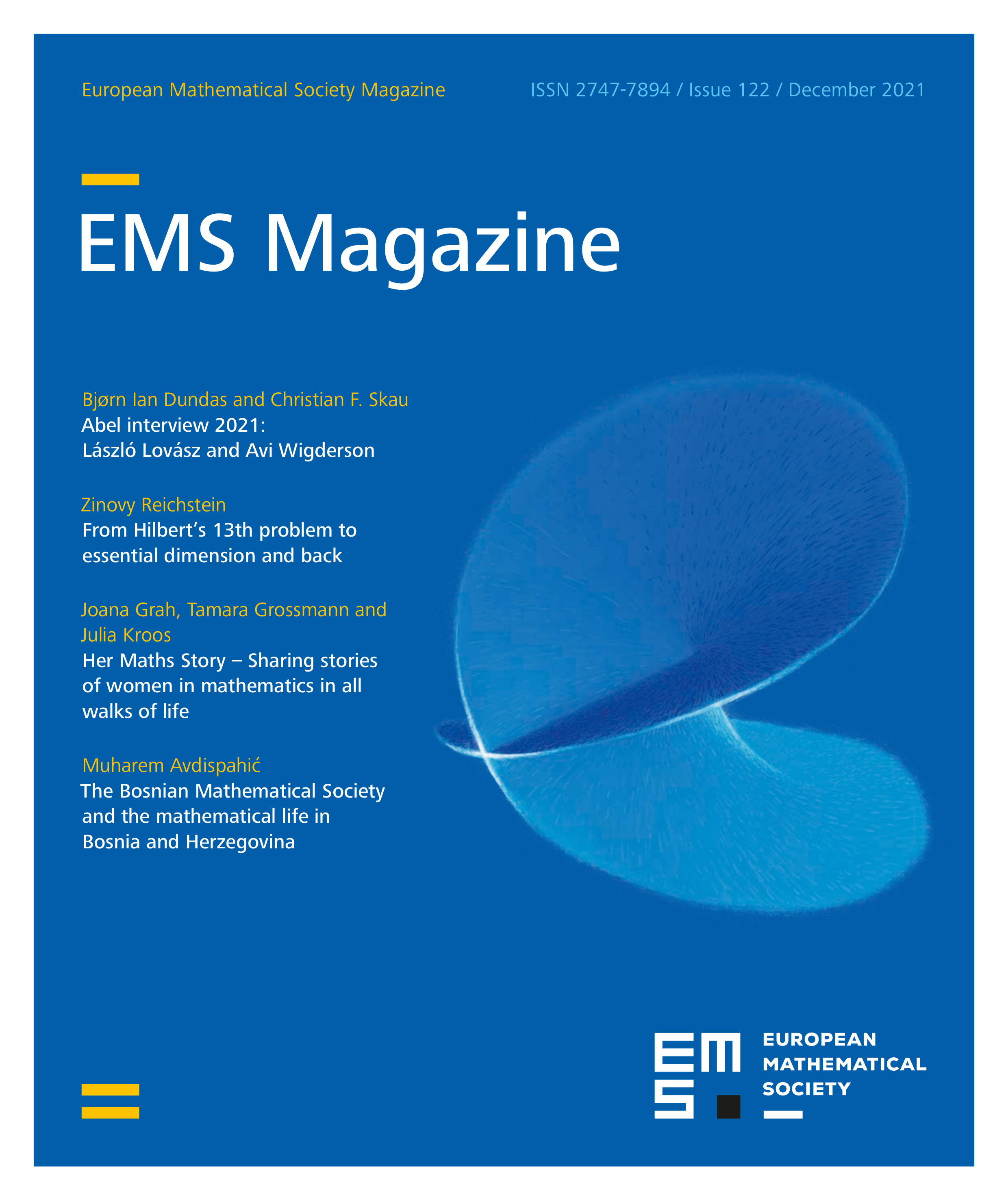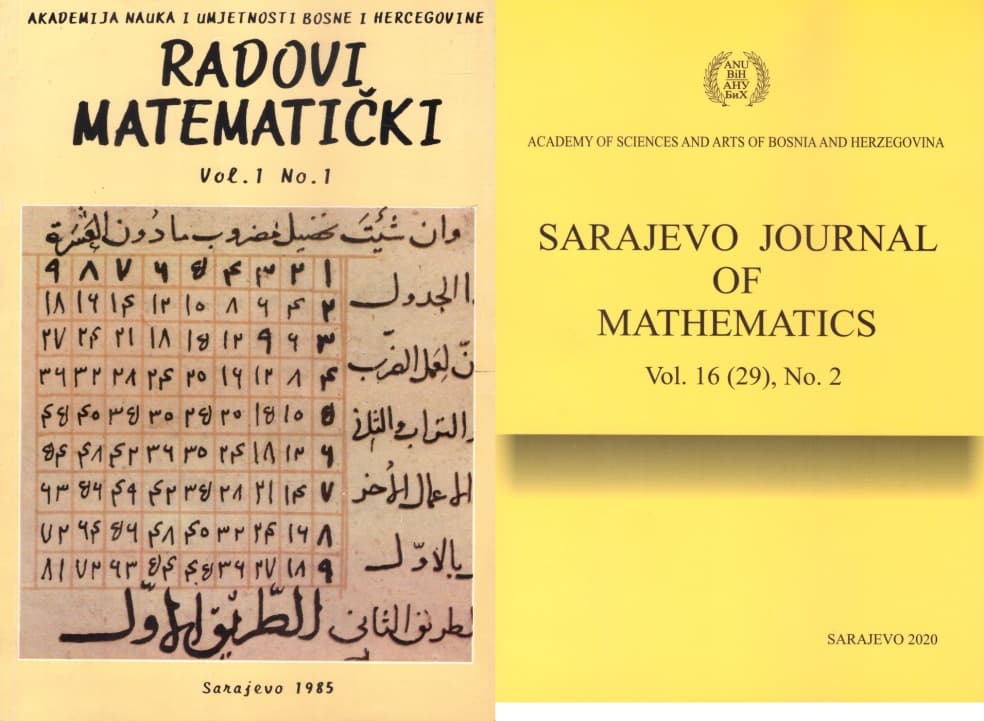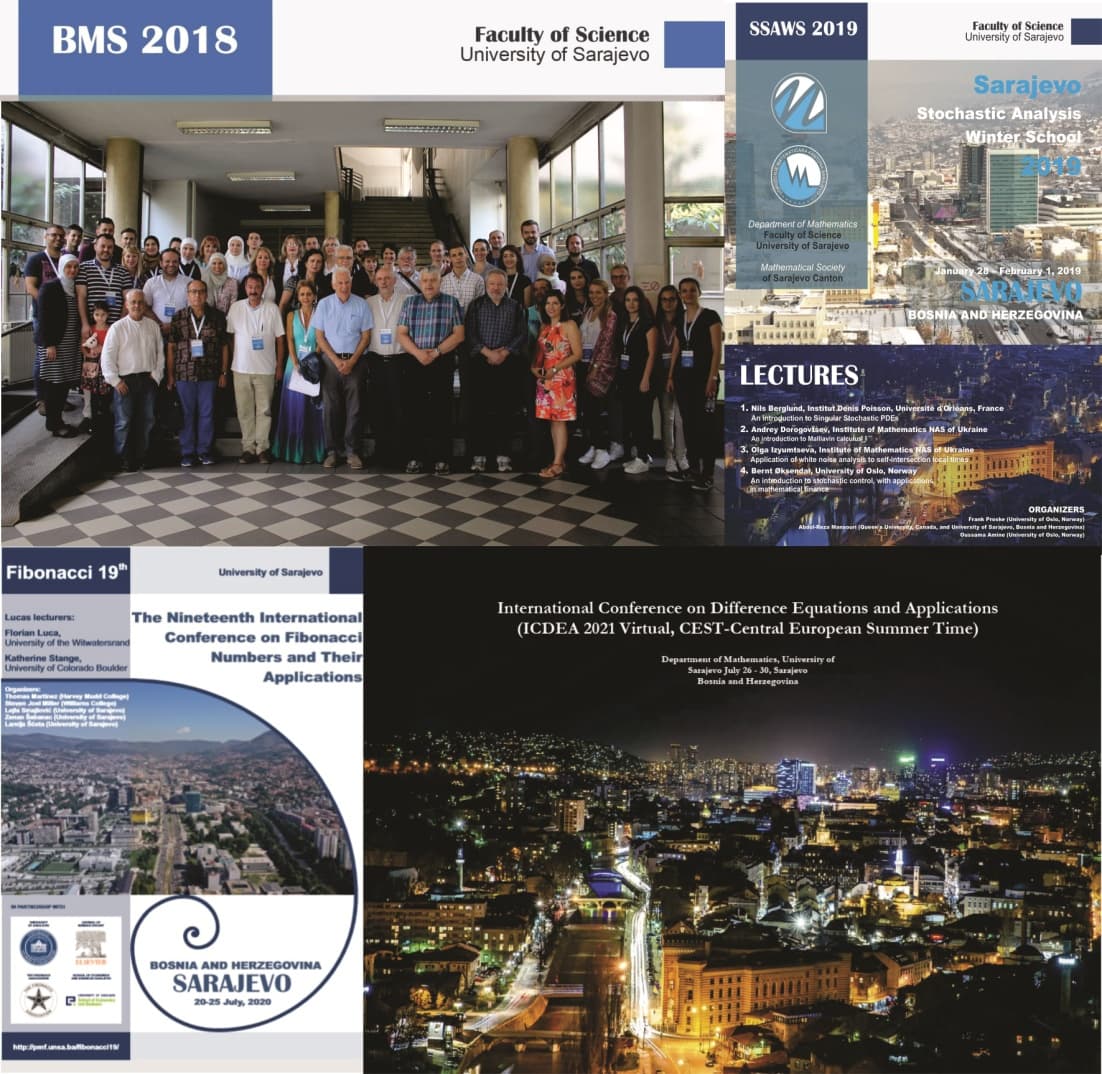The Bosnian Mathematical Society grew out of the Mathematics Section of the Society of Mathematicians, Physicists and Astronomers of Bosnia and Herzegovina. The latter was founded in 1949 during the preparation process for the First Congress of Mathematicians and Physicists of the Federal People’s Republic of Yugoslavia held in Slovenia that year.
As far as the earlier periods are concerned, one could say that the presence of university level educated teachers of mathematics in Bosnia and Herzegovina was closely related to the emergence of secular grammar schools in the period of Austro-Hungarian Monarchy, mainly between 1879 and 1899. (For a broader audience it might be of interest to learn that two Nobel Prize winners of Bosnian origin, Ivo Andrić (Literature, 1961) and Vladimir Prelog (Chemistry, 1975) attended the First Grammar School Sarajevo. Indeed, Ivo Andrić then enrolled in the mathematics and sciences programme at the University of Zagreb, but soon switched to humanities.)
A rather high level of school mathematics in Bosnia and Herzegovina was upheld during the period of the Kingdom of Yugoslavia; however, the number of such schools was still very limited; their teachers were mostly receiving their degrees from abroad.
The wide spread of the upper school system after WWII and the increased demand for qualified schoolteaching made it necessary to establish a first Teacher Training College in Sarajevo in 1946, followed by the creation of analogous institutions in Banja Luka, Mostar and Tuzla. Four-year university study programmes in mathematics and physics opened in 1950 at the Philosophical Faculty of the University of Sarajevo. Ten years later, the Faculty of Natural Sciences and Mathematics was established, with a Mathematics as one of its five departments. Soon after this, the non-educational sector began to express the need for qualified mathematicians as well.
As expected, the Society of Mathematicians and Physicists, its Mathematics Section in particular, concentrated its efforts during this phase on mathematics teaching, curricula design, organization of seminars for teachers and popularization of mathematics. In this period, it published a regular Bulletin containing papers related in principle to various topics in school mathematics.
One particular activity of the Society was to search for mathematically gifted students. The first competition for high school students at the level of Bosnia and Herzegovina was organized in 1959, as a part of the rich process through which participants were selected for the BMO (Balkan Mathematical Olympiad) and the IMO. This tradition has remained alive ever since, becoming enriched over time with regular participation at the JBMO, Mediterranean Mathematical Competition, European Girls’ Mathematical Olympiad, etc.
According to the report on the history of research mathematics in Bosnia and Herzegovina presented by Academician Mahmud Bajraktarević at the meeting in the Academy of Sciences and Arts of Bosnia and Herzegovina in 1978, the first modern research paper ever published by a Bosnian mathematician was the research note by Vera Šnajder in Comptes Rendus de l’Académie des Sciences, Paris, T. 192 (1931), 1703–1706. Mahmud Bajraktarević himself was the first Bosnian to obtain a doctoral degree in mathematics, with the thesis Sur certaines suites itérées which he wrote and defended in Paris in 1953.
The opening of a postgraduate programme at the Department of Mathematics in Sarajevo in 1966 marked a new phase in the development of mathematics in the country.
By the time of the above-mentioned report, mathematicians from Bosnia and Herzegovina had published around 300 papers total, in journals covered by Mathematical Reviews, Zentralblatt für Mathematik or Referativnij Zhurnal. The most visible results concerned summability, Fourier analysis and functional equations, accompanied by emerging interests in roughly twenty five other disciplines of pure and applied mathematics and early computer science. Until 1973, Sarajevo was the only centre of mathematical research in Bosnia and Herzegovina. The situation gradually changed with the opening of universities in Banja Luka, Tuzla and Mostar (between 1975 and 1977) and with some research activities also occurring in other industrial centres such as Zenica.
The Academy of Sciences and Arts, the University of Sarajevo Department of Mathematics and the Mathematics Section of the Society of Mathematicians, Physicists and Astronomers joined efforts to cofound the scientific journal Radovi Matematički, which in 1985 replaced an earlier publication of the Academy, Radovi Odjeljenja prirodnih i matematičkih nauka Bosne i Hercegovine. The decision to found this journal reflected the growing need for an independent mathematical journal with an international editorial policy.
The cover page of the journal was recognizable by reproducing interesting details from the old mathematical manuscripts kept in local libraries and museums. Multiplication table on the cover of the very first issue stem from a unique fourteenth century transcript dealing with elements of algebra and geometry and being kept in the Ghazy Husrev Bey Library established in Sarajevo in 1537.
In addition to research papers, the second issue of each volume of Radovi matematički contained a Chronicle, which served as a useful source of information about the period that brought a substantial new quality to mathematical life in Bosnia and Herzegovina. The Chronicle reported annually on the research publications and research communications of Bosnian mathematicians, colloquia and seminars at mathematical departments in the country, research fellowships and visits, published books and lecture notes, and other academic news such as data on new Ph.D.s in mathematics and new job appointments. An increasing number of graduates also started undertaking doctoral studies at prestigious universities abroad, mostly in the U.S. The Society contributed a section on its own activities, often concerning competitions and summer schools for young mathematicians.
The year 1992 was a turning point with far-reaching implications. In the process of dissolution of former Yugoslavia, Bosnia and Herzegovina gained its independence in April of that year. War broke out on the very day the country achieved international recognition. Sarajevo, its capital, was put under a siege that lasted for the next 1426 days.
By keeping the academic activities alive and fighting to preserve civilized standards under the most difficult conditions encountered by any higher education institution in Europe in the second half of the 20th century, the University of Sarajevo received broad international respect. On the initiative of Professor Friedrich Hirzebruch, the Bosnian Mathematical Society was accepted into the European Mathematical Society at the Council meeting in Zurich in 1994.
Soon after the Dayton-Paris Peace Accord was signed in December 1995, the TEMPUS projects CME Information Technology Development and JEP Developing the Faculty of Science Activities coordinated by University of Sarajevo contributed to the academic reconstruction of studies in mathematics and natural sciences at all public universities in Bosnia and Herzegovina.
The graduate school at the Department of Mathematics in Sarajevo enrolled a new generation of students in 1997. Volume 8 of Radovi matematički received the timestamp 1992–1996. The BMS continued to co-edit this journal until 2005, when the role of Radovi matematički was taken over by its successor, the Sarajevo Journal of Mathematics published by the Academy.
Bosnia and Herzegovina became a full member of the IMU in 2002, represented through the BMS as an adhering organization.
BMS was also a founding member of the MASSEE (Mathematical Society of South Eastern Europe) in 2003. An initiative of a BMS representative at the annual MASSEE meeting in 2008 resulted in a three years TEMPUS JEP Doctoral Studies in Mathematical Sciences in South East Europe coordinated by University of Sarajevo and involving a consortium of 11 institutions from five West Balkan and three EU countries. The efforts invested towards harmonized networking programmes up to EHEA-ERA standards are well represented by six joint Ph.D. courses held during 2011 – the Year of Mathematics in South East Europe (cf. also two special issues of Mathematica Balkanica in 2010 and 2011 consisting of contributions from SEE Young Researchers Workshops).
Young aspiring mathematicians were given numerous opportunities to upgrade their capacities through summer schools within a long term DAAD project under the Stability Pact for South East Europe’s Center of Excellence for Applications of Mathematics.
Other valuable contributors to mathematical life in Bosnia and Herzegovina are also the Bulletin and Journal of the International Mathematical Virtual Institute, successors to the Bulletin of Society of Mathematicians Banja Luka.
The country’s constitution, adopted as Annex IV to the Dayton Peace Agreement, gives full responsibility in the area of education and research to lower level administrative units. There exist cantonal associations of mathematicians with seats in Sarajevo, Tuzla, Bihać, Travnik Zenica, two associations with seats in Mostar, on the territory of the entity Federation of Bosnia and Herzegovina, and two associations with seats in East Sarajevo and Banja Luka, on the territory of the entity Republika Srpska. The challenges facing any state level organization (with the exception of sports) are amply illustrated by the fact that the state level Ministry of Justice refuses to implement the decision of the Constitutional Court reached in the matter of the status of the Academy of Sciences and Arts of Bosnia and Herzegovina.
This being said, events such as the 3rd EU/US Summer School and Workshop on Automorphic Forms and Related Topics 2016, the BMS Mathematical Conference in 2018, the Sarajevo Stochastic Analysis Winter School in 2019, the International Conference on Fibonacci Numbers and their Applications in 2020 and the 26th International Conference on Difference Equations and Applications in 2021 demonstrate the level of research activities attained nowadays.
MathSciNet reports 85 papers published by Bosnian mathematicians in 2020 alone. The new areas of strength in the country appear to lie in number theory and difference equations, with noticeable advances in mathematical logic, associative rings and algebras, measure and integration theory, operator theory and general topology.
Cite this article
Muharem Avdispahić, The Bosnian Mathematical Society and the mathematical life in Bosnia and Herzegovina. Eur. Math. Soc. Mag. 122 (2021), pp. 52–54
DOI 10.4171/MAG/50



